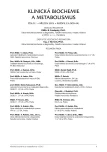Comparison of two most frequent methods for the determination of total bilirubin in newborns.
Authors:
T. Šálek 1; J. Macko 2; P. Šafařík 1; M. Pšenčík 1
Authors‘ workplace:
Oddělení klinické biochemie, Krajská nemocnice Tomáše Bati, a. s., Havlíčkovo nábřeží 600, 76 75 Zlín, ČR
1; Oddělení neonatologie, Krajská nemocnice Tomáše Bati, a. s., Havlíčkovo nábřeží 600, 762 75 Zlín, ČR
2
Published in:
Klin. Biochem. Metab., 23 (44), 2015, No. 1, p. 17-20
Overview
Aim:
The aim of the study is to compare determination of total bilirubin by direct spectrophotometric method in whole venous blood and by indirect Jendrassik-Gróf method in venous serum in 437 newborns born in Tomas Bata hospital in Zlin.
Design:
retrospective cross section design.
Methods:
Determination of total bilirubin by direct spectrophotometric method in whole venous blood was performed on Radiometer ABL 835 analyzer. Determination of total bilirubin in venous serum by indirect Jendrassik-Gróf was performed on Abbott Architect analyzer. Both methods are metrologically traceable to reference material NIST SRM 916a.
Results:
The median (interquartile range) of serum venous bilirubin was 228 µmol/L (186-263). The median of venous whole blood total bilirubin was 237 µmol/L (192-287). The significant difference between medians was found (p<0,0001). Bland-Altman plot and Passing-Bablok regression show that direct spectrophotometric method of whole venous blood gave higher results than Jendrassik-Gróf test in venous serum mainly in the concentration range above 280 µmol/l (p<0,0001).
Conclusions:
Direct spectrophotometric results of total bilirubin in whole venous blood in the concentration range above 280 umol/l should be confirmed by indirect serum determination in clinical biochemistry laboratory.
Keywords:
bilirubin, neonatal jaundice, hemolysis, interferences.
Sources
1. Bhutani, V. K., Johnson, L. Kernicterus in the 21st century: frequently asked questions. J. Perinatol. [online], 2009, roč. 29 Suppl. 1, p. S20–24. Dostupné z: doi:10.1038/jp.2008.212
2. Kaplan, M., Bromiker, R., Hammerman, C. Severe neonatal hyperbilirubinemia and kernicterus: are these still problems in the third millennium? Neonatology [online], 2011, vol. 100, iss. 4, p. 354–362. Dostupné z: doi:10.1159/000330055
3. Health, National Collaborating Centre for Women and Children´s. CG98 Neonatal jaundice: full guideline. NICE [online], [vid. 3. únor 2014]. Dostupné z: http://www.nice.org.uk/
4. Borgard, J., Szymanowicz, A., Pellae, I., Szmidt-Adjidé, V., Rota, M. Determination of total bilirubin in whole blood from neonates: results from a French multicenter study. Clin. Chem. Lab. Med. [online], 2006, vol. 44, iss. 9, p. 1437-4331. Dostupné z: doi:10.1515/CCLM.2006.202
5. Bertini, G., Pratesi, S., Cosenza, E., Dani, C. Transcutaneous bilirubin measurement: evaluation of Bilitest. Neonatology [online], 2008, vol. 93, iss. 2, p. 101–105. Dostupné z: doi:10.1159/000107351
6. Kaynak-Türkmen, M., Aydoğdu, A., Gökbulut, C., Yenisey, C., Söz, O., Cetinkaya-Cakmak, B. Transcutaneous measurement of bilirubin in Turkish newborns: comparison with total serum bilirubin. Turk. J. Pediatr., 2011, vol. 53, iss. 1, p. 67–74.
7. Kazmierczak, S., Robertson, A., Briley, K., Krea-mer, B., Gourley, G. Transcutaneous measurement of bilirubin in newborns: comparison with an automa-ted Jendrassik-Grof procedure and HPLC. Clin. Chem. [online], 2004, vol. 50, iss. 2, p. 433–435. Dostupné z: doi:10.1373/clinchem.2003.027326
8. Raimondi, F., Lama, S., Landolfo, F., Sellitto, M., Borrelli, A., Maffucci, R., Milite, P., Capasso, L. Measuring transcutaneous bilirubin: a comparative analysis of three devices on a multiracial population. BMC Pediatr. [online], 2012, vol. 12, p. 70. Dostupné z: doi:10.1186/1471-2431-12-70
9. Koseoglu, M., Hur, A., Atay, A., Cuhadar, S. Effects of hemolysis interferences on routine biochemistry parameters. Biochem. Med. (Zagreb), 2011, vol. 21, iss. 1, p. 79–85.
10. Procházka, J., Bořecká, K., Lánská, V. Vliv hemolýzy na stanovení celkového a přímého bilirubinu. Klin. Biochem. Metab., 2013, vol. 21 (42), iss. 4, p. 215–219.
11. Larsson, B., Nörstmo, A., Guthenberg, C., Olsson, G., Danielsson, P., Hagenfeldt, L., Elander, G., Larsson, A. The routine sampling procedure for PKU should be changed. Venous puncture is less painful than heel lancing. Läkartidningen, 1997, vol. 94, iss. 49, p. 4625–4628.
12. Friedecký, B. Kvalita v klinické laboratoři a bezpečnost pacientů. Klin. Biochem. Metab., 2010, vol. 18 (39), iss. 2, p. 136–143.
Labels
Clinical biochemistry Nuclear medicine Nutritive therapistArticle was published in
Clinical Biochemistry and Metabolism

2015 Issue 1
Most read in this issue
- Comparison of two most frequent methods for the determination of total bilirubin in newborns.
- Problems of measuring PTH in following chronic renal disease: A minireview.
- Recommendation for laboratory screening of inborn defects in the first and second trimester of pregnancy
- State of standardization for determination of catalytic concentration of alkaline phosphatase as viewed by different programs of external quality control: Our view of the situation and its solution.
